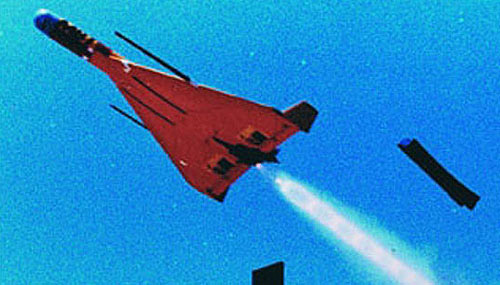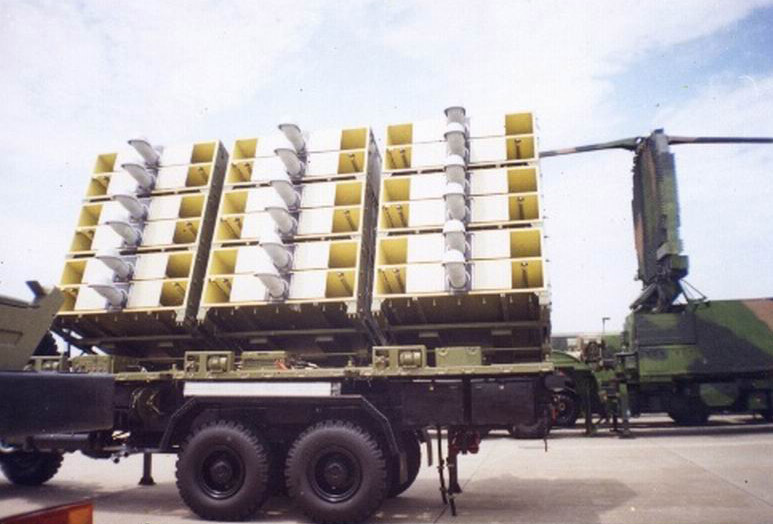| Harpy Unmanned Aerial Vehicle
中国引进的“哈比”无人机 Date:2010-02-17 Source:internet By:globalmil Viewed: |

IAI Harpy UAV (IAI)
PLA acquired an unknown number of the Israel Aerospace Industries (IAI) Harpy unmanned aerial vehicle (UAV) in 1994. The deal was not revealed until late 2004, when Washington was reported to have pressured the Israeli government to ‘roll back’ its defence relations with China. According to the reports, the U.S. intelligence spotted the PLA deploying Harpy UAV in its joint exercise held near the Taiwan Strait in 2004.
在1994年PLA从以色列飞机工业有限公司(IAI)获得未知数量的“哈比”(Harpy)无人机(UAV)。交易直到2004年后期前没有被透露,华盛顿强迫以色列政府‘降低’它同中国的防务关系。依照报告,2004年美国情报发现了PLA在台湾海峡附近联合演习中部署“哈比”UAV。
The Harpy is a unique weapon system with features of both UAV and cruise missile. The system is designed to detect, attack and destroy enemy radar. Launched from ground vehicle or surface ship far away from the battle zone, the UAV flies autonomously to the patrol area. The UAV’s radar seeker constantly search for hostile radar signal. Once the enemy radar is detected, the system can automatically compare the signal with its database and prioritise the threat of the target. Once the enemy radar is verified, the UAV make a near vertical dive to the target and destroy it with its high explosive warhead. The warhead is set to detonate just above the target to maximise the damage. The smart UAV can also abort the attack and continue loitering if enemy radar signal disappears during the attack.
“哈比”是一种具有UAV和巡航导弹特征的一种独特的武器系统。系统设计去发现、攻击和摧毁敌人的雷达。从远离战争地域的地面车辆或水面舰艇上发射,UAV自主飞行到巡逻区域。UAV的雷达搜索头通过搜索敌方雷达信号。敌人的雷达一但被发现,系统能自动地把信号与它的数据库比较并且优先目标的威胁。一但敌人的雷达被核实,UAV对目标做出一个近乎垂直向下俯冲并用它的高爆弹头破坏它。弹头被设定正好在目标上方来引爆来获得损害最大值。如果敌人的雷达信号在攻击期间消失,智能的UAV也能中止攻击并盘旋。

PLA Harpy launcher mounted on a 6X6 truck (Chinese Internet) .PLA无人机发射装置安装在一辆6X6卡车上(中国英特网)
The PLA has reportedly returned some of its Harpy UAV back to Israel in 2004 to be upgraded with new seekers that enable visual identification and attack of target even after the enemy radar emitter is turned off. This would further enhance the PLA’s capabilities in UAV and anti-radiation warfare. The PLA may also uses the Harpy technology to improve the performance of its own designs.
PLA在2004年已经据传闻送回一些它的“哈比”UAV给以色列,采用新的搜索头去升级甚至能够在敌人雷达发射器关闭之后视力辨认和攻击目标。这会更进一步提高PLA的UAV和反辐射战能力。PLA也可能使用“哈比”技术改良它自己设计的性能。
Last update: 1 February 2009
最后更新:2009年2月1日
上一篇:Jian-7 Target Drone 下一篇:WuZhen-5 Unmanned Reconnaissance Aerial Vehicle
| Sea Cavalry SD-40 Maritime UAV
中国海上骑兵SD-40海上无人机 |
| Sea Cavalry SD-40 is a vertical take-off and landing (VTOL) unmanned aerial vehicle (UAV) designed and manufactured by Chinese manufacturer Xiamen Hanfeiying Aviation Technologies.... [2023-05-25] |
| Harbin BZK-005
中国哈尔滨BZK-005型高空长航时无人机 |
| The BZK-005 high-altitude, long-range UAV is a reconnaissance aircraft designed by Beijing University of Aeronautics & Astronautics and Harbin Aircraft Industry (Group) Co., Ltd.... [2017-06-25] |
| Wing Loong Unmanned Aerial Vehicle (UAV), China
中国翼龙(Wing Loong)无人机 |
| Wing Loong (Yilong / Pterodactyl) is a medium-altitude, long-endurance (MALE), unmanned aerial vehicle (UAV) developed by Chengdu Aircraft Design & Research Institute (CADI), a division of the Aviation Industry Corporation of China (AVIC).... [2016-02-18] |
| Xianglong Unmanned Reconnaissance Aerial Vehicle
中国“翔龙”无人侦察机 |
| During the Air Show China 2006, the Chengdu Aircraft Corporation (CAC) unveiled the model of its “Xianglong” unmanned aerial vehicle (UAV) concept. The UAV appeared to be a high-altitude, long-duration UAV for strategic reconnaissance ro... [2010-02-22] |
